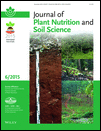Diagnosis of nitrogen status in Chinese cabbage (Brassica rapa chinensis) using the ratio of amide II to amide I in leaves based on mid-infrared photoacoustic spectroscopy
Abstract
In order to quickly diagnose the nitrogen status of Chinese cabbage (Brassica rapa chinensis), Fourier transform mid-infrared photoacoustic spectroscopy, a nondestructive and rapid approach was used. Two clear stable peaks, in the range 1680–1650 cm−1 associated with amide I and in the range of 1530–1520 cm−1 associated with amide II, were observed and responded positively to nitrogen treatments. The characteristic bands of amide I and amide II were also accurately separated by curve-fitting via deconvolution using a Gauss expansion function. The ratio of the photoacoustic intensities of amide II to amide I was used for correlation analysis with nitrogen treatment, and the correlation coefficients (R2, n = 59) at seedling and growth stage were 0.9769 (P ≤ 5%) and 0.9884 (P ≤ 5%), respectively. The ratio of the amide II and amide I peaks was found to be an indicator of nitrogen input during the seedling stage such that a ratio of less than 0.9 indicated a low nitrogen input, a ratio between 0.9 and 1.0 indicated a moderate nitrogen input, and a ratio of more than 1.0 implied an excessive N input.
1 Introduction
Chinese cabbage (Brassica rapa chinensis) is one of the most widely used and popular vegetables in China (Ren et al., 2013; Wang et al., 2014). However, nitrate, ranging from 1500 to 4000 mg N kg−1, can be accumulated in cabbage, posing health problems such as nasopharyngeal and esophageal cancer (Luo et al., 2006). Therefore, the management of nitrogen fertilizers for cabbage production has become an important concern for public health.
Conventional methods for the diagnosis of nitrogen status in vegetables include direct visible observation and chemical determination. Despite the convenience of diagnosis based on visible symptoms, this method can result in errors due to both the subjectivity of observers and symptoms from factors other than nitrogen such as diseases or pest attacks (Bellairs et al., 1996). Chemical analysis is accurate but is cost and labor-consuming (Zhang et al., 2014). Furthermore, the long duration that chemical determination requires makes it difficult to immediately take measurements to guarantee the quality of crops. Therefore, a rapid and accurate approach to diagnose nitrogen the status is needed in cabbage production.
In recent years, a spectral approach, which is a rapid and nondestructive method, has been widely used to measure the component concentrations as well as to classify the breed of agricultural products (Wu et al., 2010; Xie et al., 2009; Jie et al., 2013; López et al., 2013). Reflectance spectroscopy and photoacoustic spectroscopy have been used to characterize Chinese cabbage and different spectral features were obtained (Yang et al., 2013). Photoacoustic spectroscopy captured more information from leaves (Yang et al., 2013), because plant materials are susceptible to scattering (Rai and Singh, 2003). Furthermore, photoacoustic spectroscopy provides a depth-profiling ability, which helps to obtain comprehensive information about the plant nutritional status (Rai and Singh, 2003; Yang et al., 2013). Currently, photoacoustic spectroscopy is used in the fields of gas monitoring (Bozóki et al., 2011; Dahnke et al., 2000), food safety (Dóka et al., 1991; Döka et al., 1998), and plant diseases (Gupta et al., 2001) using both qualitative and quantitative analyses (Li et al., 2011). Compared to the near-infrared spectrum (12500–4000 cm−1), the mid-infrared spectrum (4000–400 cm−1) includes a wealth of information about the base frequency of functional groups with high resolution (Kokaly and Clark, 1999; Kos et al., 2004; Tao et al., 2014). Accordingly, mid-infrared photoacoustic spectroscopy can be used for the diagnosis of nitrogen status in Chinese cabbage.
The amide I band, which is in the range of 1680–1630 cm−1 and mainly arises from C=O vibrational stretching, is used to analyze protein secondary structural composition and conformational changes (Barth, 2007; Kong and Yu, 2007; Ami et al., 2011). The amide II band, which is in the range 1570–1510 cm−1 and mainly due to N–H deformation vibration and C–N stretching vibrations, contains weaker information about protein conformational sensitivity than amide I (Kong and Yu, 2007). Since amides are a major storage form of nitrogen in plants (Lam et al., 1996; Cao and Li, 2003; Zhang, 2011), the mid-infrared photoacoustic spectra of Chinese cabbage, especially the regions closely linked to amide, should enable rapid nitrogen analysis.
The objectives of this study were to determine the responses of mid-infrared photoacoustic spectra to nitrogen supplies and to establish an alternative quantitative diagnosis method involving amide I and amide II to monitor the nitrogen status in Chinese cabbage.
2 Material and methods
2.1 Leaf samples
The seeds of Chinese cabbage (Brassica rapa chinensis cv. Shanghaiqing) were wetted with distilled water and were geminated at 24°C for 12 h. The geminated seeds were then sown in gauze covers, which were fixed on a 5 L plastic container with 1/5 Hoagland solution (Hoagland and Arnon, 1950). After germination, similar small seedlings with two leaves were transferred into 5 L plastic containers treated with modified Hoagland solution in which only the nitrogen concentration was modified using four treatments of 0 mM, 2 mM, 13 mM, and 27.6 mM N, which are abbreviated as CK, N1, N2, and N3, respectively (Table 1). There were 16 seedlings in each container with four replicates. During the entire growth period the nutrient solutions were renewed every 3 d. The pH was regulated in the range of 6.0–6.2 by adding KOH (0.01 M), and O2 was supplied by an oxygen pump from 9:00 to 11:00 and from 14.00 to 16:00 each day.
| Nitrogen concentration / mM | Treatments | Ca(NO3)2 / mM | NaNO3 / mM | CaCl2 / mM | KNO3 / mM | KH2PO4 / mM | K2SO4 / mM | MgSO4 / mM |
|---|---|---|---|---|---|---|---|---|
| 0 | CK | 0 | 0 | 4 | 0 | 1 | 2.5 | 2 |
| 2 | N1 | 1 | 0 | 3 | 0 | 1 | 2.5 | 2 |
| 13 | N2 | 4 | 0 | 0 | 5 | 1 | 0 | 2 |
| 27.6 | N3 | 4 | 14.6 | 0 | 5 | 1 | 0 | 2 |
Leaf samples were taken in the seedling stage (12 d after treatment, when there were three leaves for CK and four to five for other treatments) and growth stage (22 d after treatment, when there were three leaves for CK and five to seven for other treatments), and the biggest leaf sample from each plant was selected for spectral determination with three replications. Other samples were harvested 36 d after treatment and weighed for determination of nitrate and total nitrogen by laboratory analysis (Wang, 2008). Nitrate was determined using the salicylic acid digestion method. After cutting into small pieces and mixing, the fresh samples were weighed with 2–3 g using an electronic lab balance and were then solved in deionized water for extraction. Salicylic acid reacted with the filtered solution and then NaOH was added to the mixed solution for color development. Nitrate concentration was determined using the ultraviolet spectroscopy at 410 nm (BioTek, USA). About 0.1 g of dried leaves was weighed and then digested by concentrated sulfuric acid and hydrogen peroxide in the digestion instrument, and total nitrogen was determined using a continuous flow analysis apparatus (Smartchem 200, Westco Scientific Instruments Inc., Italy).
2.2 Mid-infrared photoacoustic spectroscopy measurements
A Fourier transform infrared spectrometer (Nicolet 6700, USA) coupled with a photoacoustic accessory (Model 300, METC, USA) was used. A piece of sample from the middle part of the sample leaves was placed in a cell cup (5 mm height, 10 mm diameter) for spectrum recording. In total, 59 samples were collected for determination of spectra. During the measurement, the sample was purged with dry helium (10 mL min−1) to remove interferences from CO2 and H2O. Thirty-two scans were performed in the range 4000–500 cm−1 with a resolution of 4 cm−1 and a mirror velocity of 0.32 cm s−1. Carbon black was used as a reference.
2.3 Data processing
Principal component analysis (PCA) was used to reduce the dimensions of spectral data by providing new variables, which were a linear combination of the original variables (Abdi and Williams, 2010). Wavelength selection methods and the correlation coefficient method (Chu, 2011) were used to determine the most useful and representative spectral range linked to nitrogen applications.
 ()
() ()
()where a1, a2, and a3 are the constants that represent the peak amplitude, position, and width, respectively, while x and y are the wavenumber and intensity, respectively.
PCA and correlation analyses were conducted in Matlab R2013a (the Math Works, NatiCK, USA) to select wavelength, and curve-fitting based on deconvolution was calculated using Peakfit v4.12.
3 Results and discussion
3.1 Spectral characterization
Mid-infrared photoacoustic spectra of Chinese cabbage leaves from seedling and growth stage are shown in Fig. 1. The spectra displayed similar total shapes for all treatments and typical bands were observed from the mid-infrared photoacoustic spectra. Bands in the range 3800–3100 cm−1 were assigned to N–H stretching and O–H stretching vibrations (Lu et al., 2014). Small shoulder peaks around 2900 cm−1 were assigned to C–H stretching vibrations. In this wave-number range, the intensity and position of each absorption band significantly varied among spectra both at seedling and growth stage, possibly resulting from variations in the water condition of the fresh leaf samples.

Mid-infrared photoacoustic spectra of leaves from Chinese cabbage cultivated in nutrient solution with four NO3-N levels of 0 mM, 2 mM, 13 mM, and 27.6 mM at (a) seedling stage and (b) growth stage.
Two strong bands occurred in the range of 1570–1510 cm−1 and 1680–1630 cm−1. These bands mainly corresponded to amide II and amide I, respectively, which are known as the main form of nitrogen storage in plants (Zhang, 2011). There were large differences in the intensities of the two bands, but the position of each band remained approximately constant, enabling the diagnosis of nitrogen status. The bands in the range between 1300 cm−1 and 1000 cm−1, regarded as fingerprint absorptions, mostly resulted from C–O and C–C stretching vibrations (Chu, 2011). Since these vibrations were not directly related to nitrogen, they were not used to monitor nitrogen status.
Despite the spectral variations that occurred in the range of 1570–1510 cm−1 and 1680–1630 cm−1, direct correlations to the level of nitrogen were not found. However, distinct levels of nitrogen supply altered nitrogen and carbon metabolism, followed by a change in foliar component and structure, which could be observed in the infrared spectra. Therefore, further treatment of the spectral data was necessary to extract target information that could directly diagnose the nitrogen status of Chinese cabbages.
3.2 Nitrogen diagnosis by principal component analysis (PCA)
The score plots of the first two principal components of the two stages are shown in Fig. 2. The first two principal components (PC1) and (PC2) accounted for 76.12% of the total variance in the seedling stage and 74.69% of the total variance in the growth stage. These first two components contained massive information about the spectra of these samples. However, the score plot exhibited an irregular pattern across all the samples in the seedling stage. In the growth stage, the N3 samples were well distributed with the negative PC1 scores, and the PC2 scores of CK were negative, while the first two scores from the other treatments still showed an irregular pattern.
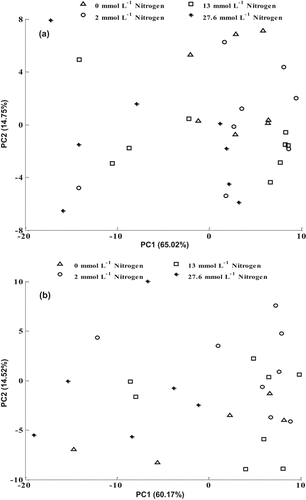
Principal component distributions based on mid-infrared photoacoustic spectra of Chinese cabbage leaves cultivated in nutrient solution with four NO3-N treatments of 0 mM, 2 mM, 13 mM, and 27.6 mM at (a) seedling stage and (b) growth stage. The explained variance of the first principle component (PC1) and the second principle component (PC2) are shown in brackets.
Some treatments were difficult to distinguish with PCA, because the scores merely contained more information about the original independent variables but failed to consider the relationship between the independent and dependent variables (Godoy et al., 2014). The poor performance of PCA based on full wavelength may be attributed to some variables being unrelated to nitrogen management. Some studies have also suggested that the full spectrum may include some useless and irrelevant information, which reduces the prediction ability, robustness, and accuracy of the models. Fortunately, wavelength selection methods can improve model performance and stability (Xie et al., 2009; Wu et al., 2010; Mehmood et al., 2012; Jie et al., 2013). Therefore, selecting some variables associated with nitrogen improve the search for spectral differences among different treatments.
3.3 Wavelength selection based on correlation analysis with nitrogen supply
The poor performance of PCA may be attributed to having too many variables from the spectral region unrelated to nitrogen. Some specific regions, which were linked to nitrogen metabolism, were observed in the correlation analysis between variables and nitrate treatments. Only bands in the range of 1700–1400 cm−1 in the seedling stage and a similar region between 1800 cm−1 and 1200 cm−1 in the growth stage showed a consistently positive relationship with nitrogen additions (Fig. 3). These specific regions were then selected for further spectral analysis.
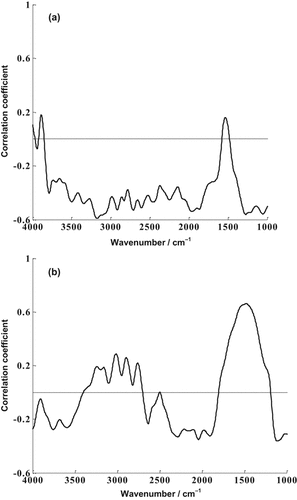
Correlation analysis between wavenumber variables and NO3-N applications of leaves of Chinese cabbage at (a) seedling stage and (b) growth stage.
3.4 Curve-fitting through deconvolution of a selected wavelength
Compared to Fig. 1, two large peaks closely related to amide I and amide II were observed at the range positively associated with nitrogen supply (Fig. 3). The spectrum in this region was divided into several isolated peaks, and the two peaks indicative of amide in the two stages are shown in Figs. 4 and 5. The correlation coefficient (R2) between raw spectrum and fitted spectrum was above 0.88, and the standard errors were less than 1.
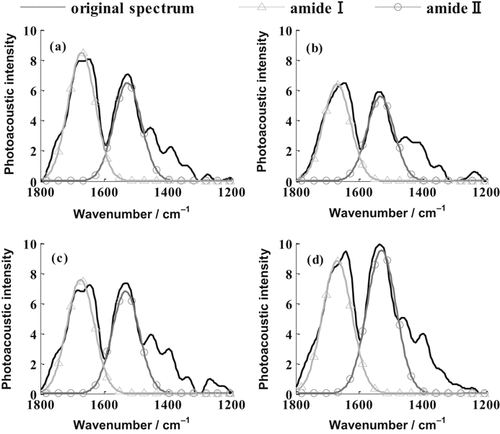
Deconvolution curve-fitting in seedling stage. (a) 0 mM N treatment (CK), (b) 2 mM N treatment (N1), (c) 13 mM N treatment (N2), and (d) 27.6 mM N treatment (N3).
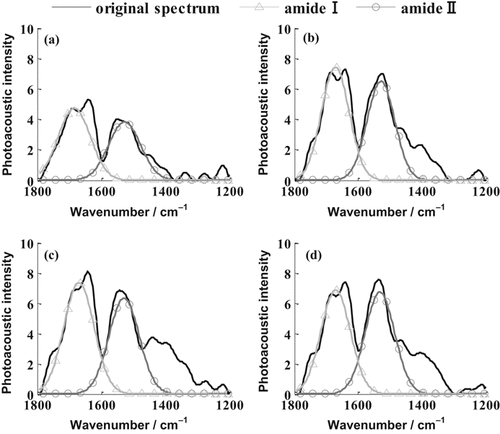
Deconvolution curve-fitting in growth stage. (a) 0 mM N treatment (CK), (b) 2 mM N treatment (N1), (c) 13 mM N treatment (N2), (d) 27.6 mM N treatment (N3).
As can be seen in Figs. 4 and 5, the two peaks occurred at nearly the same wavenumber independent of treatment. The first peak was at approximately 1680–1660 cm−1 and the second one occurred at about 1530–1510 cm−1. The former resulted from the C=O stretching vibration of amide I, while the latter was related to a combination of the N–H deformation vibration and the C–N stretching vibration of amide II (Van de Weert et al., 2001; Kong and Yu, 2007; Chu, 2011). Furthermore, amide I of both the primary and secondary amides occurred in the same range of 1680–1630 cm−1, while amide II of the primary and secondary amide occurred in the ranges 1650–1620 cm−1 and 1570–1510 cm−1, respectively (Hu and Zheng, 2011).
During nitrogen metabolism, ammonia may be toxic to plants even at low concentrations. Therefore, it is assimilated into organic forms of nitrogen such as glutamine or glutamate via glutamine synthetase or glutamate synthase (Maynard, 1942; Crawford, 1995; Lam et al., 1996; Zhang, 2011). Since amide is the main storage form of nitrogen, the spectrum showed some peaks corresponding to amide I and amide II in response to different nitrate treatments.
3.5 Diagnosis of nitrogen status through the ratio (the photoacoustic intensity of amide II to amide I)
The fresh biomass, NO3-N concentration, and total nitrogen concentration of harvested samples are shown in Table 2. In comparison to the other three treatments, the CK treatment most clearly prohibited development. The average fresh weight, nitrate, and total nitrogen showed very low levels, and there was no significant difference in fresh biomass among N1, N2, and N3.
| Treatment | NO3-N supply / mM | Fresh biomass / g per−1 | NO3-N / mg g−1 | Total N / mg g−1 |
|---|---|---|---|---|
| CK | 0 | 3.13 b | 0.08 d | 17.66 c |
| N1 | 2 | 45.59 a | 0.28 c | 34.96 b |
| N2 | 13 | 50.45 a | 0.54 b | 51.17 a |
| N3 | 27.6 | 49.50 a | 0.81 a | 40.23 b |
Additionally, superfluous nitrogen fertilizer was easily absorbed by leaf vegetables as a result of nitrate accumulation in the plants. In this study, NO3-N was apparently accumulated in Chinese cabbages when the NO3-N supply increased (Table 2); an especially high level of 0.81 mg g−1 was found for N3-treated vegetables. For total nitrogen, there were significant differences between the other two treatments and N2, which had the highest level of approx. 51.17 mg g−1 (Table 2). No difference was found between N1 and N3 (Table 2), again demonstrating that vegetable development was inhibited by the N3 treatment. Obviously, the N2 treatment was suitable for sustaining plant growth, because a large production moderates NO3-N accumulation, and high total nitrogen concentrations were achieved. Therefore, CK, N1, N2, and N3 treatments can be considered extremely low, relatively low, modest, and excessive NO3-N supplies, respectively.
In the spectra, to avoid interference from the equipment and environment while measuring differences in the absolute values of the peak intensities, a ratio of the photoacoustic intensity of amide II to amide I in Chinese cabbages was calculated. Figure 6 shows that the correlation between the ratio and nitrogen supplies was relatively high with a coefficient of more than 0.97 both in the seedling and in the growth stage. In the seedling stage, the ratio of N1, N2, and N3 was above 0.90, whereas the ratio of CK was only 0.82 (Fig. 6a), implying that having no nitrogen supply causes an imbalanced metabolism as indicated by the low ratio. The supposition was that both primary and secondary amides are the dominant storage forms of nitrogen (Lam et al., 1996; Zhang, 2011) to reduce the risk of toxic levels of ammonia in plants. At a high nitrogen input, more nitrogen was transformed into secondary amides (Fig. 6a). However, the ratio of both the low and modest nitrogen supply was between 0.90 and 1.00, illustrating that the vegetable could sustain, develop, and avoid nitrate accumulation according to the ratio in the spectrum at an early stage.
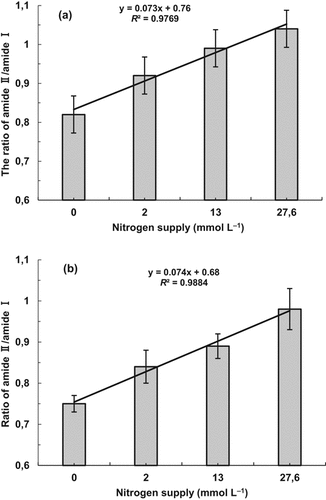
(a) Linear regression between NO3-N applications (0 mM, 2 mM, 13 mM, 27.6 mM) and the ratio of the photoacoustic intensity of amide II to amide I based on the mid-infrared photoacoustic spectra of Chinese cabbage leaves at (a) seedling stage and (b) growth stage. The linear functions and the square of the correlation coefficient (R2) are shown in the left top corner of each plot.
In addition, the linear correlation at the first stage (R2 = 0.9769) was almost the same as that of the second stage (R2 = 0.9884), indicating that the ratio tended to stabilize during the development of Chinese cabbage. However, the ratios of all treatments clearly decreased in the growth stage (Fig. 6b). During plant growth, photosynthesis was more intense as a result of an increase in organic carbon and nitrogen utilization and a decline in nitrogen stored in the form of secondary amides. Thus, the ratio decreased during plant development. Therefore, the ratio in the seedling stage was more suitable for diagnosis.
4 Conclusion
The ratio of the peak intensities of amide II and amide I from photoacoustic spectra was found to positively respond to different nitrate treatments in Chinese cabbage, and the ratio in the seedling stage was more suitable for nitrogen diagnosis than that in the growth stage. A ratio of less than 0.9 indicated low levels of nitrogen, suggesting the addition of nitrogen. As the ratio increased to 0.9–1.0, the nitrogen treatments enabled vegetable growth without massive nitrate accumulation. A ratio above 1.0 indicated an excessive nitrogen input owing to high levels of accumulated nitrate and potential decrease in production.
Acknowledgements
This work was supported by the National Scientific Foundation of China (41130749).



